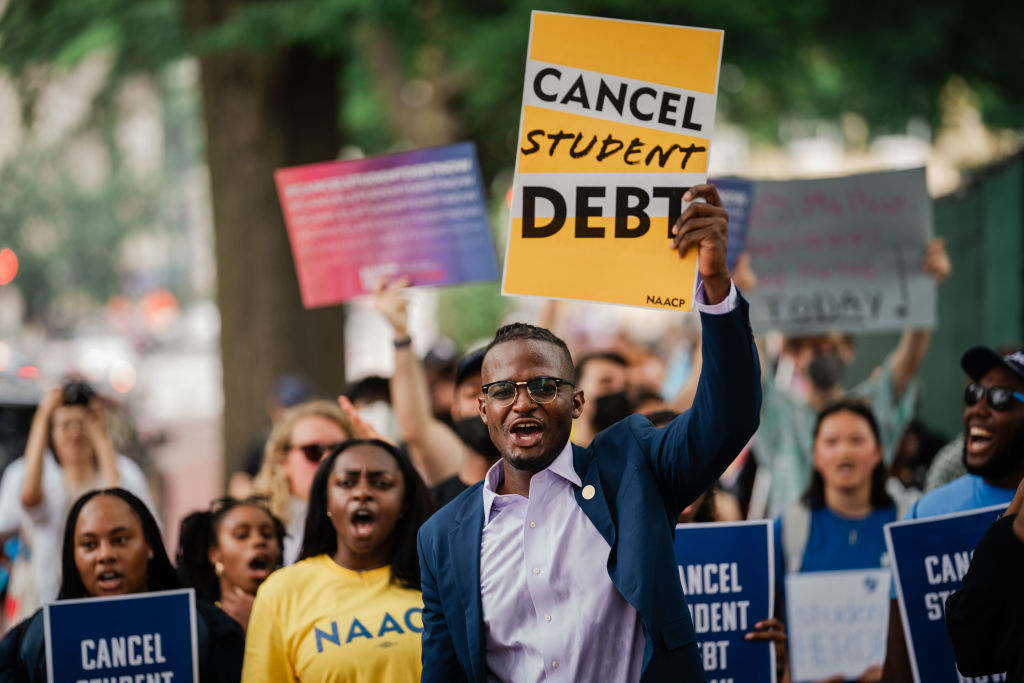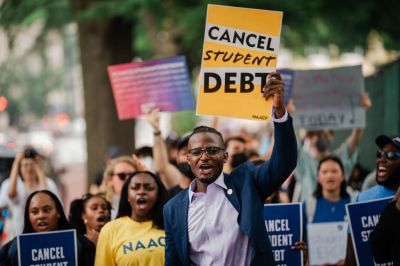President Joe Biden announced last week the cancellation of $1.2 billion in student debt for 153,000 borrowers—an average of $7,843 per borrower. The move is one of dozens he’s made since 2021 in a multi-pronged strategy to deliver on his campaign promise to “forgive a minimum of $10,000/person of federal student loans.”
To date, Biden has approved the cancellation of $138 billion in student debt for 3.9 million borrowers —an average of $35,384 per borrower, according to the White House.
What about that Supreme Court decision?
One could be forgiven for thinking that the student debt cancellation issue was settled in June 2023 when the Supreme Court struck down the Biden administration’s rule attempting to cancel student debt using the national emergency provisions of the HEROES Act. Had it survived the legal challenge, the move would have canceled $20,000 in student debt for borrowers originally from lower-income families and $10,000 for most others. The Congressional Budget Office estimated that around $400 billion in debt would have been canceled under the program if it had survived the lawsuit.
On the day the court released its decision, Biden announced his Plan B: to work through required regulatory channels to achieve broad-based debt cancellation using authorities granted in the Higher Education Act. Uniquely for the Higher Education Act, this involves a slow and iterative process called negotiated rulemaking, explained here. Less noticed was that the administration reiterated its commitment to a series of actions to cancel student debt in other ways. Even after the Supreme Court defeat, the White House’s message was “Debt Relief for As Many Borrowers as Possible, as Fast as Possible.” There are dozens of White House press releases relating to actions taken on student debt cancellation since last summer.
Student debt: a quick recap.
The Congressional Budget Office estimated that as of mid-2022, 43 million borrowers owed $1.6 trillion in federal student debt—about $37,000 per borrower. Add in private and state student loans and the total comes to around $1.78 trillion. By comparison, in 2006, student borrowers owed $724 billion (adjusted for inflation), meaning student debt has more than doubled in an era when undergraduate enrollment has declined and postgraduate enrollment has only modestly increased.
Yet most borrowers didn’t make any payments on their federal student loans in the 43 months from March 2020—when the Trump administration suspended student loan payments and set interest rates to zero percent because of the COVID-19 pandemic—to October of 2023, when the payment pause ended under the Fiscal Responsibility Act of 2023.* Because loans are often in forbearance while students are in school, an 18 year-old who entered college in September 2016 may never have made a payment before turning 25. So while the debt conversation has been in part about borrowers struggling to make payments, millions of borrowers have never made a payment at all.
How has the administration been canceling so much debt?
The Department of Education has been working since 2021 to cancel student debt using a variety of tools, and it would have done so even if the Supreme Court had upheld broad-based loan relief under the HEROES Act. That rule only provided $10,000 in debt cancellation to most borrowers, and other tools have been used to cancel considerably more. The administration’s multi-pronged approach includes one primary new program and a series of changes to existing programs.
The new element is Biden’s Saving on a Valuable Education (SAVE) plan, an income-based repayment plan promising lower payments and full debt cancellation after 10 years. Borrowers already enrolled in certain income-driven repayment programs have been automatically enrolled in SAVE, and others can opt into the program if they qualify. Last week’s relatively modest $1.2 billion debt cancellation announcement was the first to arise from the SAVE program—but its long-term potential for debt cancellation is massive: The Penn-Wharton Budget Model estimates the 10-year cost of the program to be $475 billion.
The Biden administration’s changes to existing student loan programs include, in roughly descending order of impact:
- Adjusting the Public Service Loan Forgiveness (PSLF) program to maximize the amount of debt forgiven. Congress created PSLF in 2007, promising to forgive student loans for those in nonprofit or public service professions after 10 years of qualifying payments. But bureaucratic requirements defeated most borrowers’ efforts to attain forgiveness under the program as administered. In the first year in which applications for forgiveness were possible, the department approved fewer than 300 applications for discharge out of 28,000 submitted. The Biden administration’s effort to cancel debt under PSLF depends largely on loosening the criteria under which borrowers qualify for forgiveness. This includes payment count adjustments, which are more lenient in counting loan payments toward forgiveness. Using this approach, the Biden Department of Education has canceled at least $42 billion in loans held by 615,000 borrowers—a remarkably high average of $68,200 per borrower.
- Using payment count adjustments to cancel more debt under the Education Department’s several existing Income-Driven Repayment (IDR) plans. IDR plans were introduced by Congress in the 1990s and grew to include a series of variations on a basic theme: monthly payments are calibrated to the borrower’s income level, and the debt is discharged after 20 or 25 years of qualifying payments. IDR programs are a central reason student loan balances have, on average, been increasing in recent years, since many monthly payments were well below what was necessary to reduce the loan’s balance. Capitalized interest meant the principal often grew, and the process would only end when forgiveness came in 20 or 25 years. Except it often didn’t—showing that all 20 or 25 years of payments were qualifying payments, in the right repayment plan, etc., turned out to be very hard for most borrowers to do. By making IDR plans more permissive in how they account for qualifying payments, the department has canceled $39 billion in debt for 804,000 borrowers, or $48,500 per borrower.
- Canceling debt under the Borrower Defense to Repayment rule. Borrower defense is a decades-old statute allowing students to challenge their debt on the grounds that the college they attended engaged in misrepresentation or fraud. These matters are handled case-by-case, but the department discharged $3.9 billion in debt for former students of ITT Technical Institute, an average of $18,750 per student.
- Canceling debt for borrowers judged to have a total and permanent disability. The Biden Department of Education has canceled $5.8 billion for 323,000 borrowers, or $17,950 per borrower.
- Canceling debt for borrowers who attended a school that closed during their time as students. These matters are also handled school-by-school, but the department discharged $5.8 billion for 560,000 borrowers who attended the for-profit Corinthian Colleges, averaging $10,350 per borrower. Closed-school debt cancellations have happened before, but never on this scale.
In the longer run, the two biggest tools in the administration’s debt-cancellation toolbox are the SAVE plan and the ongoing rulemaking under the Higher Education Act—Biden’s “Plan B.”
If SAVE is implemented and survives the almost-inevitable judicial challenges, it will do the following, according to the Department of Education:
- Cut many borrowers’ monthly payments in half, from 10 percent of discretionary income to 5 percent.
- Eliminate many payments altogether. The Department of Education has increased the living expense exclusion to a level that means many borrowers will have no discretionary income under the formula. In this case, even a monthly “payment” of $0 will be counted as part of the 10 years of payments that qualify for full loan forgiveness.
- If interest on the loan exceeds the borrower’s monthly payment, that interest will be forgiven.
- Loan balances will be forgiven after 10 years of payments.
- Married couples who file taxes separately can separate their incomes for purposes of SAVE.
The ongoing rulemaking could be important, too, but its details won’t be clear until the department issues a final rule. That said, the department’s draft rule, released in December, suggests that debt cancellation will be focused on borrowers who:
- Carry balances greater than what they borrowed
- Entered repayment many years ago
- Are eligible for forgiveness under existing programs but have not applied for relief
- Enrolled in programs that didn’t deliver enough financial value
- Are experiencing financial hardships not addressed by existing programs
Several of the Biden administration’s debt cancellation efforts are likely to face challenges in court—probably the SAVE plan, and certainly whatever comes out of the ongoing rulemaking process. But opponents of student debt cancellation need to have legal standing to sue, and as the many lawsuits attacking the first Biden debt cancellation plan demonstrated, that can be a difficult hurdle to clear in cases of this kind.
Even before its bigger debt cancellation projects have had time to bear fruit, the administration has canceled billions in debt, and most of those efforts have resulted in considerably more debt forgiveness on a per-borrower basis than the broad-based debt-relief program invalidated by the Supreme Court. If SAVE and “Plan B” survive judicial review, the Biden administration may succeed in canceling hundreds of billions of existing—and future—student debt.
*Correction, March 1, 2024: This story originally miscounted the number of months student loan payments were suspended due to COVID-19.






Please note that we at The Dispatch hold ourselves, our work, and our commenters to a higher standard than other places on the internet. We welcome comments that foster genuine debate or discussion—including comments critical of us or our work—but responses that include ad hominem attacks on fellow Dispatch members or are intended to stoke fear and anger may be moderated.
With your membership, you only have the ability to comment on The Morning Dispatch articles. Consider upgrading to join the conversation everywhere.